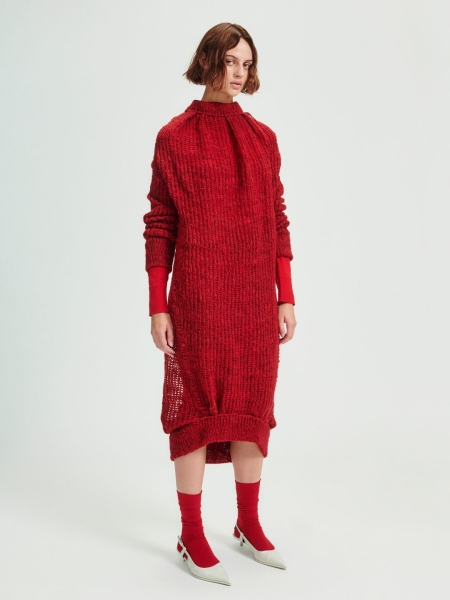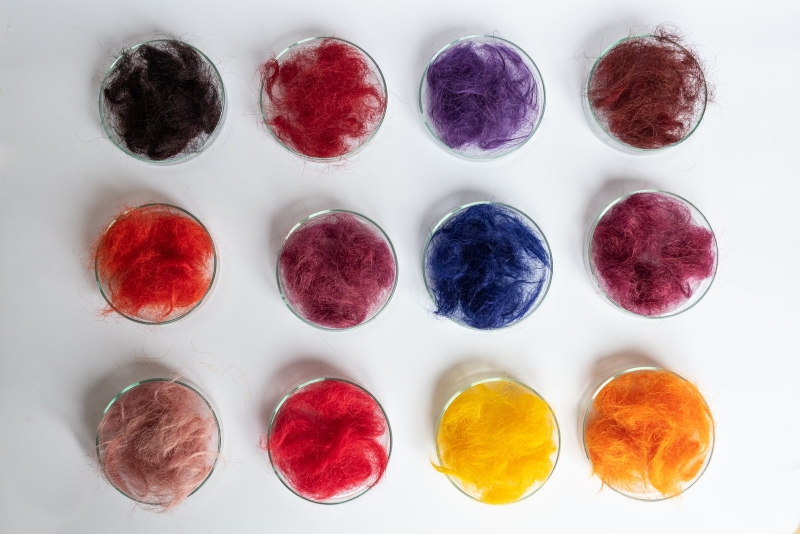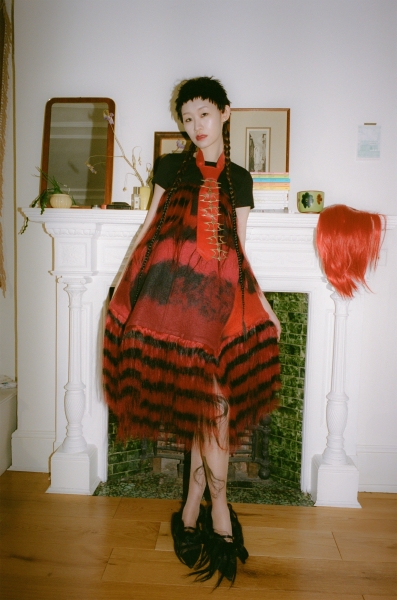As fashion looks to become more sustainable, we’ve seen a whole assortment of alternative materials hit the market, from mushroom leather to seaweed yarns and everything in between. One potential fabric of the future that may surprise you? Human hair.
Royal College of Art student Javiera Decap became interested in using human hair in their work, after noticing its similarities with the wool from long-haired sheep in their native Norway. “Our neighbor is a farmer, and has tonnes of bags of wool—I asked if I could use some of it,” the designer tells Vogue. “I wanted to use this specific wool, because [it] looks like human hair. I came back to the UK, and my tutor was like, ‘Why don’t you use [actual] human hair, because it looks so similar?’”
While the likes of Dilara Fındıkoğlu have incorporated human hair into their work in the past (see looks 26 and 27 from the designer’s spring 2023 collection), Decap’s approach differs in that they treat it pretty much like any other fibre. The MA student asked a London salon if they could use its hair waste, which would typically just be thrown away. They then began treating it, cleaning it with conditioner (“because a lot of the hair that I’ve gotten is already treated or has been bleached, so it’s really dry”), and straightening it. After that, they combined the human hair with the Norwegian wool by needle-felting the fibres together (which involves using special needles to stab the fibres repeatedly, until they become a firmer felt), before dyeing it with semi-permanent and permanent dye that they use on their own hair.

The result? Printed felt dresses and hairy skirts, which you’d never be able to tell contained human hair. In fact, Decap says the responses of people on discovering that the pieces were made from human hair have been interesting, to say the least. “Some people get a bit like, ‘Oh, ew, I don’t want to touch your clothes,’” the designer explains. “It’s actually quite funny, because the human hair is more treated than the wool I’ve been using.”
In fact, trying to understand why people are so repulsed by human hair is why Zsofia Kollar decided to set up Human Material Loop. “I always had a really strong fascination with human hair,” the founder says. “Once it’s cut on the floor in a hair salon, it’s just so neglected; many people also find it very uncanny and repulsive. So I was like, how can we inject new value into this material?”
On discovering how polluting the textiles industry is, Kollar saw the potential of human hair as a more sustainable material of the future – particularly due to its structural similarities with wool. In fact, the designer and researcher has developed a green chemical process to transform the human hair into a wool-like fibre that can be used in existing machinery. “There are no colors, we increase the crimpage, and we increase the friction, so the fibres stick better together,” she explains. “If you’re not an expert, you [wouldn’t be able to tell the] difference between wool and human hair after processing.”

The strength of human hair, thanks to its protein structure, along with the fact that it can be easily dyed, makes it ideal for the textile industry. Plus, it has a much lower carbon footprint than most virgin materials, considering that it’s currently just waste. “We just did our first LCA [Life-Cycle Assessment]—we have 99 times less CO2 impact than cotton, from gate to gate,” Kollar says. “If we scale up, it’s going to be such a game changer. From cradle to gate, we basically have no impact.”
Currently, Human Material Loop sources its hair directly from salons, but plans to collaborate with waste management companies in the future. While human hair doesn’t come with the same animal welfare concerns as wool, ensuring that the supply chain is “100 per cent transparent” is still important.
Indeed, Decap became concerned with the dark side of the human hair trade, during their research. There have been reports of women in the Global South being exploited for either their own hair, or working as hair collectors for poverty wages. “The hair trade, even though it’s legal, is entirely unregulated,” the designer notes.
Still, if sourced in an ethical manner, human hair has a huge potential to be a sustainable material of the future. If one major barrier can be overcome, that is. “The challenge to scaling it up is to really make people accept this material as something new, and not something that’s disgusting,” Kollar concludes.

